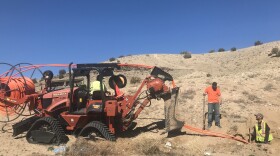What if big telecom isnŌĆÖt the only game in town for internet service? . And whatŌĆÖs more, theyŌĆÖre making net neutralityŌĆöunthrottled access to an open netŌĆöa core value.
Jose Lovato was driving out to a substation in Taos thatŌĆÖs also a hub for their broadband network. He helped lead the charge to bring reliable internet service to the mountainous regions of northern New Mexico when major telecom companies just wouldnŌĆÖt do it. "I was very fortunate to be out there on the first connections that was the most rural town, which was in Amalia, straight north of here" he said, "and able to see them get internet, this type of speeds, for the first time ever, was monumental. It was ecstatic. And this was a community that my mother was from."
Amalia is near the Colorado border, and Lovato grew up in neighboring Costilla. Both towns have about 200 residents.

LovatoŌĆÖs the co-opŌĆÖs outside plant manager and fiber optics systems engineer. When he started working through how to bring reliable broadband up here, he said he was trying to level the playing field. Small towns had been struggling with internet speeds just a fraction faster than dial-up before the co-op started constructing its network six years ago. "My dad never used a computer up until I put a fiber-optic line to his house, and now I canŌĆÖt get him off of Craigslist," Lovato laughed. "So itŌĆÖs little things like that they have grown from that they never had before."
Co-op members through , are getting fast, reliable service, for less than what most customers are paying in bigger cities.
"The people own the network," Lovato said, "so if they want to see changes, they get to vote and tell us what they like to see and what they donŌĆÖt like seeing. So itŌĆÖs them having their voice."
Co-ops and do-it-ourselves community projects are inspiring other people to build networks that they controlŌĆöespecially as net neutrality protections disappear. a Brooklyn-based multi-media publication, has been covering for years, looking at how .
Jason Koebler is MotherboardŌĆÖs editor in chief. "What weŌĆÖve seen is people who are frustrated in a lot of these cities that are underserved have started building their own networks," he said. "So these are small community groups that have been buying a connection and then giving it away for free or really cheap to the local community."
On the day the FCC voted to , based in its Brooklyn headquarters. The plan is to document every step of the process, so anyone who wants to can build an alternative network. Koebler is hoping it will be running this summer. "We are trying to do it as bare bones as possible, because we want people to be able to do the same thing if they donŌĆÖt have a huge budget," he said. "What we are imagining is that this is the type of thing that a community group could crowdfund."
Service can be spotty in urban environments, tooŌĆöjust like it used to be all over Taos County. , and advocates there say itŌĆÖs a civil rights issue. .
"Ultimately this is sort of about digital freedom and internet access equality," he said. "One way to make the recent ruling by the FCC irrelevant is if a lot of these smaller networks pop up all over the country."
Co-ops in New Mexico that offer broadband are making the same choice to provide unhindered access to the net. Andrew Gonzales is the telecom manager for Kit Carson. "WeŌĆÖve arbitrarily chosen not to do any type of speed-throttling or to do any type of price-gouging against our customer baseŌĆöor our member baseŌĆöbecause this is their network," he said.

At the Kit Carson Co op in New Mexico, leaders there have vowed to preserve neutrality on their network, too. "As a member-owned cooperative, weŌĆÖre much different than an investor-owned telecommunications company where itŌĆÖs about return on investment and bottom line."
Gonzales said Kit Carson wonŌĆÖt discriminate against any neighborhood or area based on class, and it wonŌĆÖt arbitrarily spike rates. The co-opŌĆÖs mission is to serve everyone.
Š┼╔½═° co-reported that story with Leah Todd, a reporter with the . ItŌĆÖs all a part of the ŌĆ£ŌĆØ project produced in collaboration with the Solutions Journalism Network and other newsrooms around New Mexico.





